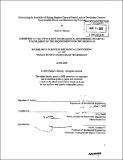Determining the feasibility of making bamboo charcoal pencil leads in developing countries using graphite pencil lead manufacturing processes
Author(s)
Elkordy, Nadia S
DownloadFull printable version (29.86Mb)
Other Contributors
Massachusetts Institute of Technology. Dept. of Mechanical Engineering.
Advisor
Amy Smith.
Terms of use
Metadata
Show full item recordAbstract
Many organizations seek to alleviate poverty in the developing world. One organization in particular strives to improve the livelihood of people in poverty through the technical development of and training in bamboo and rattan enterprises, the International Network for Bamboo and Rattan (INBAR). A team in the Spring 2008 D-Lab: Design class has been collaborating with members of INBAR located in India to develop the processes and tools necessary to make pencils from bamboo, rather than wood. The communities that launch this enterprise will need to outsource the glue and graphite leads required to complete the pencils. Waste is generated by cutting processes used to dimension the bamboo to appropriate pencil size and from the parts of the bamboo stalk that cannot be used in pencils, the nodes. If this bamboo waste is carbonized to charcoal, it can be made into pencil leads, eliminating the need for communities to purchase graphite leads from an external source. Manufacturing pencil leads from bamboo waste could raise the profit generated by the enterprise, create more jobs, and help to alleviate poverty in regions of the world where it is widespread. This thesis presents factors affecting the feasibility of using graphite pencil lead manufacturing processes to make bamboo charcoal pencil leads using clay as a binder. The feasibility is determined by modeling industrial-scale graphite pencil lead manufacturing techniques with small-scale methods that are replicable in a developing country and then comparing the resulting charcoal lead performance to graphite lead performance qualities, including the ability of the lead to write smoothly on paper and its ability to be erased. Experimentation conducted found that vitrification of the charcoal leads is possible at kiln temperatures in excess of 1250 °C and that a sufficiently reducing environment could be simulated using a capped steel nipple. However, a higher performance lead that makes marks comparable to a graphite pencil lead can be attained by simply heat-drying or sintering the charcoal pencil leads and coating them in wax.
Description
Thesis (S.B.)--Massachusetts Institute of Technology, Dept. of Mechanical Engineering, 2008. Includes bibliographical references (p. 44).
Date issued
2008Department
Massachusetts Institute of Technology. Department of Mechanical EngineeringPublisher
Massachusetts Institute of Technology
Keywords
Mechanical Engineering.